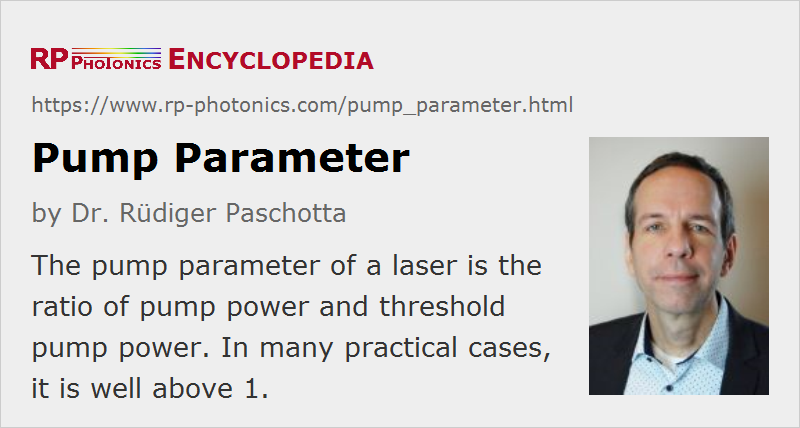Pump Parameter
Definition: the ratio of pump power and threshold pump power of a laser
German: Pumpparameter
Category:  laser devices and laser physics
laser devices and laser physics
Units: (dimensionless number)
Formula symbol: <$r$>
Author: Dr. Rüdiger Paschotta
Cite the article using its DOI: https://doi.org/10.61835/xyy
Get citation code: Endnote (RIS) BibTex plain textHTML
The pump parameter <$r$> of a laser is the ratio of pump power and threshold pump power. Usually, this quantity is used for optically pumped lasers in continuous-wave operation.
Most lasers are operated with a pump parameter between 3 and 10, i.e. significantly but not very far above threshold. This is because extreme values often have some disadvantages:
- For small pump parameters (close to 1), the power conversion efficiency is reduced, the output power depends sensitively on the pump power, and the relaxation oscillations are weakly damped.
- For very large pump parameters, diffraction-limited beam quality is often difficult to achieve (at least in bulk lasers), since e.g. small tails of the pump intensity profile can excite higher-order modes. Also, the power efficiency may be degraded due to the strong influence of parasitic resonator losses.
Extreme values of pump parameters are nevertheless required in some cases:
- Some single-frequency lasers have to be operated with small pump parameters because for stronger pumping additional resonator modes would start to oscillate.
- High-power fiber lasers are often operated far above threshold simply because the threshold power is very low, even with strong output coupling.
- Passively mode-locked lasers often have to be operated far above threshold in order to suppress Q-switching instabilities.
Particularly in the context of four-level lasers, it can be convenient to use the pump parameter <$r$> in equations, as it is most easy to evaluate in an experiment, and thus often well known. In four-level lasers, the intracavity optical intensity in the gain medium (in the steady state, assuming a flat-top mode profile) is (<$r - 1$>) times the saturation intensity. Also, there is a simple equation for the frequency of relaxation oscillations, containing the parameter <$r$>. However, such equations then often do not hold for (quasi-)three-level gain media.
More to Learn
Encyclopedia articles:
Blog articles:
Questions and Comments from Users
Here you can submit questions and comments. As far as they get accepted by the author, they will appear above this paragraph together with the author’s answer. The author will decide on acceptance based on certain criteria. Essentially, the issue must be of sufficiently broad interest.
Please do not enter personal data here; we would otherwise delete it soon. (See also our privacy declaration.) If you wish to receive personal feedback or consultancy from the author, please contact him, e.g. via e-mail.
By submitting the information, you give your consent to the potential publication of your inputs on our website according to our rules. (If you later retract your consent, we will delete those inputs.) As your inputs are first reviewed by the author, they may be published with some delay.



Connect and share this with your network:
Follow our specific LinkedIn pages for more insights and updates: